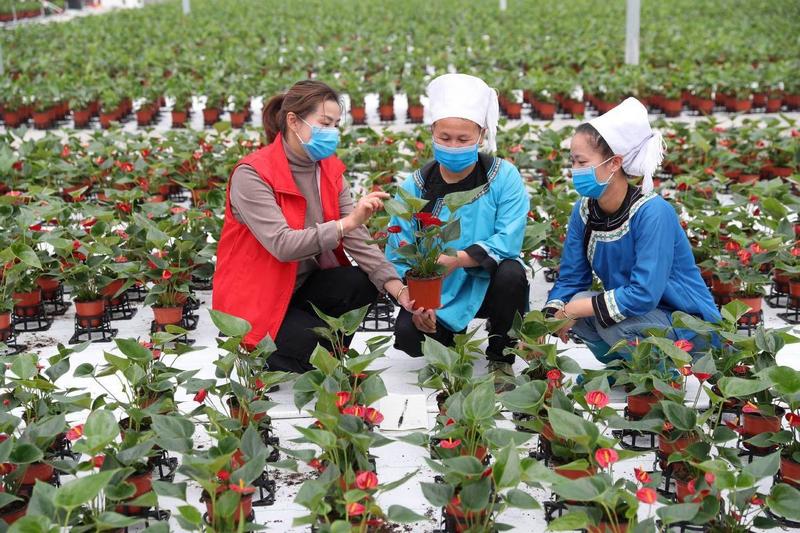 Villagers learn flower planting skills at Gaojiu village, Xinghua township of Rongjiang county in Southwest China's Guizhou province, March 8, 2020. (PHOTO / XINHUA)
Villagers learn flower planting skills at Gaojiu village, Xinghua township of Rongjiang county in Southwest China's Guizhou province, March 8, 2020. (PHOTO / XINHUA)
China will stay on track to wipe out domestic poverty in 2020, even after economic repercussions triggered by the novel coronavirus pneumonia outbreak fueled concerns that the deadline could be missed, a senior official in charge of poverty alleviation said on Thursday.
Liu Yongfu, head of the State Council Leading Group Office of Poverty Alleviation and Development, said the victory over absolute poverty is already on the horizon. A good indicator is that the number of rural poor-one of two indexes that authorities have been using to track progress-plummeted to about 5.51 million by the end of last year.
The number of rural poor-one of two indexes that authorities have been using to track progress-plummeted to about 5.51 million by the end of last year, Liu Yongfu, head of the State Council Leading Group Office of Poverty Alleviation and Development, said
The number stood at 98.99 million in late 2012, when nationwide poverty relief gained momentum, he said at a news conference held by the State Council Information Office in Beijing.
ALSO READ: China's No. 1 central document prioritizes poverty relief
In order to escape the label of being poverty-stricken, a person has to rise above the national poverty line-defined as an annual per capita income of 2,300 yuan set in 2010 and adjusted annually for inflation-before fulfilling other criteria such as access to schooling, healthcare, safe housing and clean drinking water, according to official documents.
Liu said the actual poverty line had reached over 3,000 yuan (US$427) last year and would exceed 4,000 yuan this year.
Another index, the number of "impoverished counties", dropped from 832 to 52 over the same period, he added. The term is defined as places where poverty rates hover above 3 percent in the nation's western areas or 2 percent in richer coastal regions.
"Impoverished farmers' income and living conditions increased, local economies picked up and China's poverty alleviation capability improved," he said.
READ MORE: Nation won't let virus halt anti-poverty work
But Liu acknowledged that the damage caused by the COVID-19 outbreak was severe.
Travel bans installed since January have rattled logistics chains and passenger transportations, causing multibillion yuan losses in agricultural production and rural tourism. They also prevented rural workers from returning to jobs in urban areas after disruptions during and after the Spring Festival break.
The major sources of income for people from rural areas are sales of farm produce, running home-stay lodgings and jobs in urban areas.
Liu said flower farmers in Yunnan province have collectively lost billions of yuan due to the disruption, and the migrant workers who were able to reach their jobs by March 6 represented only 52 percent of last year's 27.29 million.
To ensure that the poverty battle ends as planned, Liu said they would next work to promote sales of farm produce from poor regions and help migrant workers return to their jobs as soon as possible. Efforts also will be made to ensure that those who recently shook off poverty do not slide back into it.
"Of the 93 million people who have escaped poverty, there are some whose situations are unstable and very vulnerable," he said.


